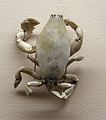Decapod
| Decapoda | |
|---|---|

| |
| "Decapoda" from Ernst Haeckel's Artforms of Nature, 1904 | |
| Scientific classification | |
| Kingdom: | |
| Phylum: | |
| Subphylum: | |
| Class: | |
| Superorder: | |
| Order: | Decapoda Latreille, 1802
|
| Suborders | |
Decapoda is an order of crustaceans in the class Malacostraca. Many familiar groups, such as crayfish, crabs, lobsters, prawns and shrimp are in this order. Many decapods are scavengers - they eat dead plants and animals. Crabs are mixed feeders, taking algae and shellfish such as molluscs. Lobsters eat mostly live prey.
Anatomy
[change | change source]As their name suggests, all decapods have ten appendages.
The last five pairs of appendages on the front half of the body, the cephalothorax, are used for walking.[1]
In many decapods, the front pair of appendages carry large pinching claws. The claws are called chelae, so these appendages may be called chelipeds.
The front three pairs of appendages on the thorax are used as jaws, and called maxillipeds.
On the abdomen are swimming appendages called pleopods, and the body ends in a tail fan.
Classification
[change | change source]Classification of the order Decapoda depends on the structure of the gills and legs, and the way in which the larvae develop. There are two suborders: Dendrobranchiata and Pleocyemata. Prawns (including many so-called "shrimp", such as the Atlantic white shrimp) make up the Dendrobranchiata. The other groups, including true shrimp, are the Pleocyemata.
The following classification follows Martin and Davis,[2] with some changes based on more recent structural and molecular studies.[3][4]x
Order Decapoda Latreille, 1802 (Selection, not everything is listed)
- Suborder Dendrobranchiata Bate, 1888 – prawns
- Suborder Pleocyemata Burkenroad, 1963
- Infraorder Caridea Dana, 1852 – true shrimp
- Infraorder Achelata Scholtz & Richter, 1995 – spiny lobsters, slipper lobsters, and furry lobsters
- Infraorder Astacidea Latreille, 1802 – lobsters and crayfish
- Infraorder Anomura MacLeay, 1838
- Superfamily Galatheoidea Samouelle, 1819 – squat lobsters
- Superfamily Paguroidea Latreille, 1802 – hermit crabs
- Infraorder Brachyura Latreille, 1802 – crabs
-
Whiteleg shrimp, Litopenaeus vannamei (actually a prawn)
-
Spotted cleaner shrimp, Periclimenes yucatanicus
-
California spiny lobster, Panulirus interruptus
-
Blue crab, Callinectes sapidus
-
Lyreidus tridentatus, another crab
References
[change | change source]- ↑ So called because the head and thorax are fused together.
- ↑ Joel W. Martin and George E. Davis (2001). An updated classification of the Recent Crustacea. Natural History Museum of Los Angeles County.
- ↑ Dixon C.J; Schram F.R. & Ahyong S.T. (2004). "A new hypothesis of decapod phylogeny". Crustaceana. 76 (8): 935–975.
{{cite journal}}: CS1 maint: multiple names: authors list (link) - ↑ Porter M.L; Pérez-Losada M. & Crandall K.A. (2005). "Model-based multi-locus estimation of decapod phylogeny and divergence times". Molecular Phylogenetics and Evolution. 37 (2): 355–369. doi:10.1016/j.ympev.2005.06.021. PMID 16112880.
{{cite journal}}: CS1 maint: multiple names: authors list (link)
Other websites
[change | change source]- Decapoda at the Open Directory Project





